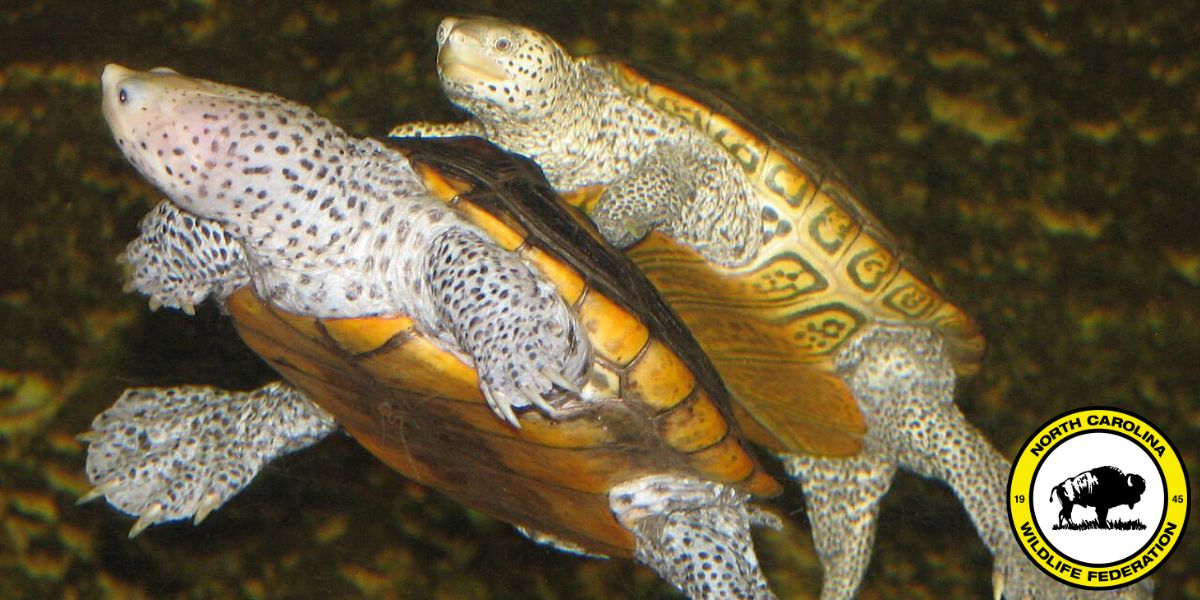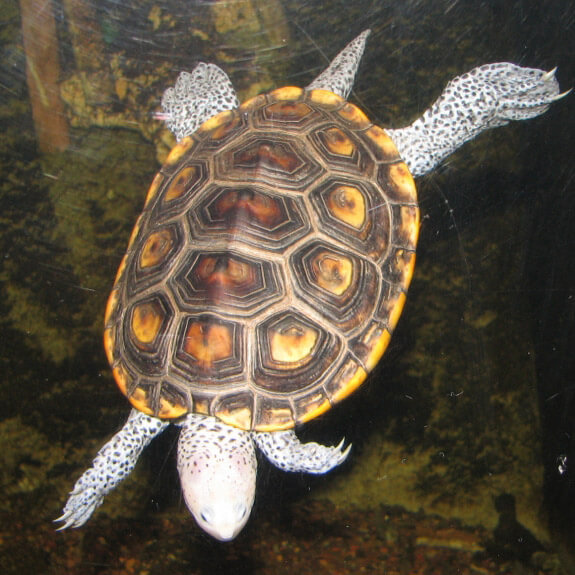Diamondback Terrapin Turtles are Going to Pot. It’s Time for a Change.

Diamondback Terrapin turtle populations on North Carolina’s coast have declined considerably due to blue crab pot by-catch mortality and other habitat-related issues, despite 22-plus years of deliberations between the North Carolina Marine Fisheries Commission (NCMFC) and North Carolina Division of Marine Fisheries (NCDMF). The conservation of this public trust resource has never been taken seriously. We think it’s time to change that.
Both terrapins and blue crabs are depleted in North Carolina, with respect to historical levels, and the NCDMF has determined that blue crabs are overfished. The North Carolina Natural Heritage Program lists the Diamondback Terrapin as “Special Concern” and the International Union for the Conservation of Nature puts the species in the “Vulnerable” risk category. The Monterey Bay Seafood Watch, a respected consumer guide, gives the NC blue crab fishery its lowest rating (avoid) due to terrapin bycatch, which hurts the North Carolina blue crab market.
The NCMFC’s recent proposal for Diamondback Terrapin Management Areas (DTMAs) was adopted last week and will go into effect in 2021. It is an insufficient baby step toward terrapin conservation and hardly reflective of a precautionary management approach to the blue crab fishery.
The North Carolina Wildlife Federation (NCWF) supports DTMAs in southern coastal areas requiring fishermen and women to use turtle excluder devices in crab pots, but found that the original proposal did not adequately address the fact that more significant by-catch mitigation measures are desperately needed.
The ongoing quantity of Diamondback Terrapin by-catch of this slow-growing, long-lived species invalidates the Commission’s claim that proposed DTMAs were sufficient. Therefore, NCWF found that commercial crabbing in the reserves is incompatible and should be eliminated.
Diamondback Terrapin Excluder Device protects hungry turtles looking for crabs
Recommendations for ecological, economic and cultural vitality

In a letter to the NCDMF and NCMFC, NCWF recommended several measures to help ensure the long-term ecological, economic and cultural vitality of North Carolina’s Diamondback Terrapin populations, and the state’s commercial and recreational blue crab fisheries:
- Extend the DTMAs from the proposed Masonboro Sound area south to the South Carolina state line, providing some protection from blue crab pot by-catch mortality in several additional areas.
- Require excluders in all blue crab pots within North Carolina waters that are subject to Diamondback Terrapin bycatch. Thanks to a device developed recently by the Keck Environmental Field Laboratory, fishermen and women can exclude Diamondback Terrapins but retain blue crabs without impacting their catch.
- Investigate and certify additional excluder designs or pot/trap modifications, such as narrow funnel entrances. New designs can prevent Diamondback Terrapins from entering pots with minimal impact on blue crab harvest.
- Implement a blue crab fishery trap limitation/reduction program, which has been successful in other east coast crustacean trap fisheries. Not only do the programs reduce overcapitalization, they also decrease the potential for ghost traps and reduce the need for trap clean-ups.
- Close blue crab pot season in all areas with confirmed Diamondback Terrapin populations.
No emotions, just facts
The proposed DTMA measures were not sufficient to restore, maintain and conserve North Carolina’s blue crab populations and maintain the fishery’s economic vitality. Nor does the proposal take the necessary steps to conserve, protect and restore Diamondback Terrapins.
Not only is our conservation position in line with our mission, goals and Sound Solutions campaign, it cites facts and scientific literature without emotional or inflammatory comments.
Learn more about how you can support North Carolina marine resources, reform and management.

